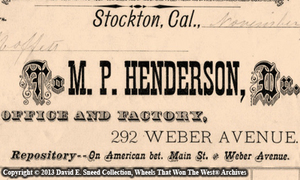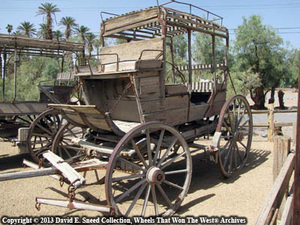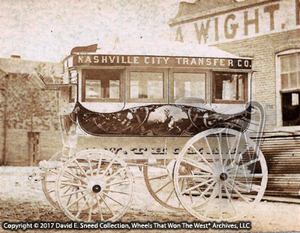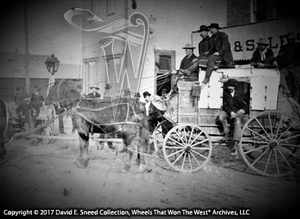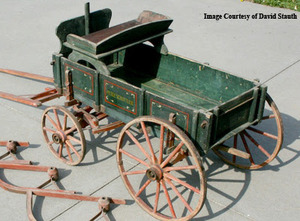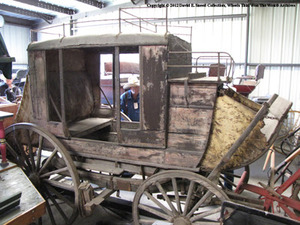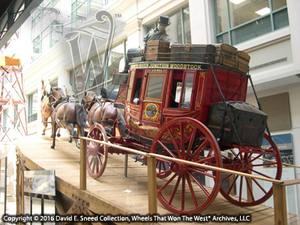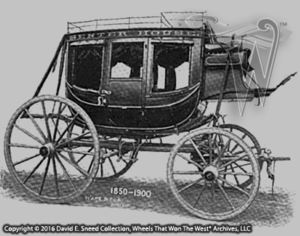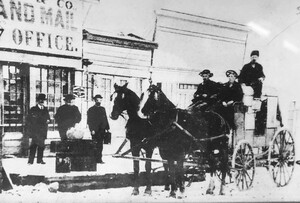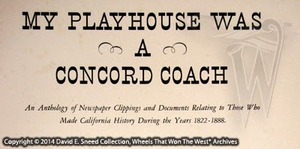Most Old West enthusiasts are familiar with a wide variety of vehicles that were used as stages in the U.S. Some are known by names such as mud wagons, celerity wagons, Heavy Overlands, Mountain Wagons, omnibuses,and others. Then, there are the true Concords; those heavy stagecoach designs with a name originating from Concord, New Hampshire. While the label comes from New Hampshire, some very similar designs were made in Troy, New York as well.Gilbert & Eaton was one of the firms in Troy known to have produced this style of coach.
Depending on the part of the country one might be in, a ‘stage’ might actually be anything from a small buggy or farm wagon to an actual thoroughbrace-engineered coach. Up until recently, I thought I’d seen about every style of coach that was built in the U.S. – including the upscale uses of Park Drags and Road Coaches. Researchers, though, are always uncovering forgotten history and that’s exactly what happened to me. While digging through the November 1877 issue of The Hub, I flipped the page and noticed a set of wheels that appeared to be a blended creation. The design seemed to carry the main body of a Concord Hotel Coach combined with stylized boots and roof top seating similar to a Park Drag or Road Coach. The image was a drawing of a coach built by the New York Transfer Company for Dodd’s Six-In-Hand coach which ran between Long Branch and Ocean Grove. The coach was dubbed, “The Atlantic.”
According to researchers with the Mike Farrell Collection of Independent Mails, Dodd' s Express carried parcels and luggage between Brooklyn and New York City as well as Long Branch, New Jersey. The company enjoyed a fairly lengthy life, being in operation from the 1860s into the 1910s. Founded by Amzi S. Dodd and C. J . Studley, the firm was originally referred to as Dodd's Express and Coach Company in the late 1850s. After roughly a decade in business, the New York and Brooklyn Passenger and Baggage Company briefly served as proprietors. In 1870, the company was incorporated as the New York Transfer Company. Mr. Dodd was the secretary and general manager of the incorporated firm until his death in 1890. For more details, visit https://www.pennypost.org/pdf/farrell/DoddsExpress_FarrellCollection.pdf
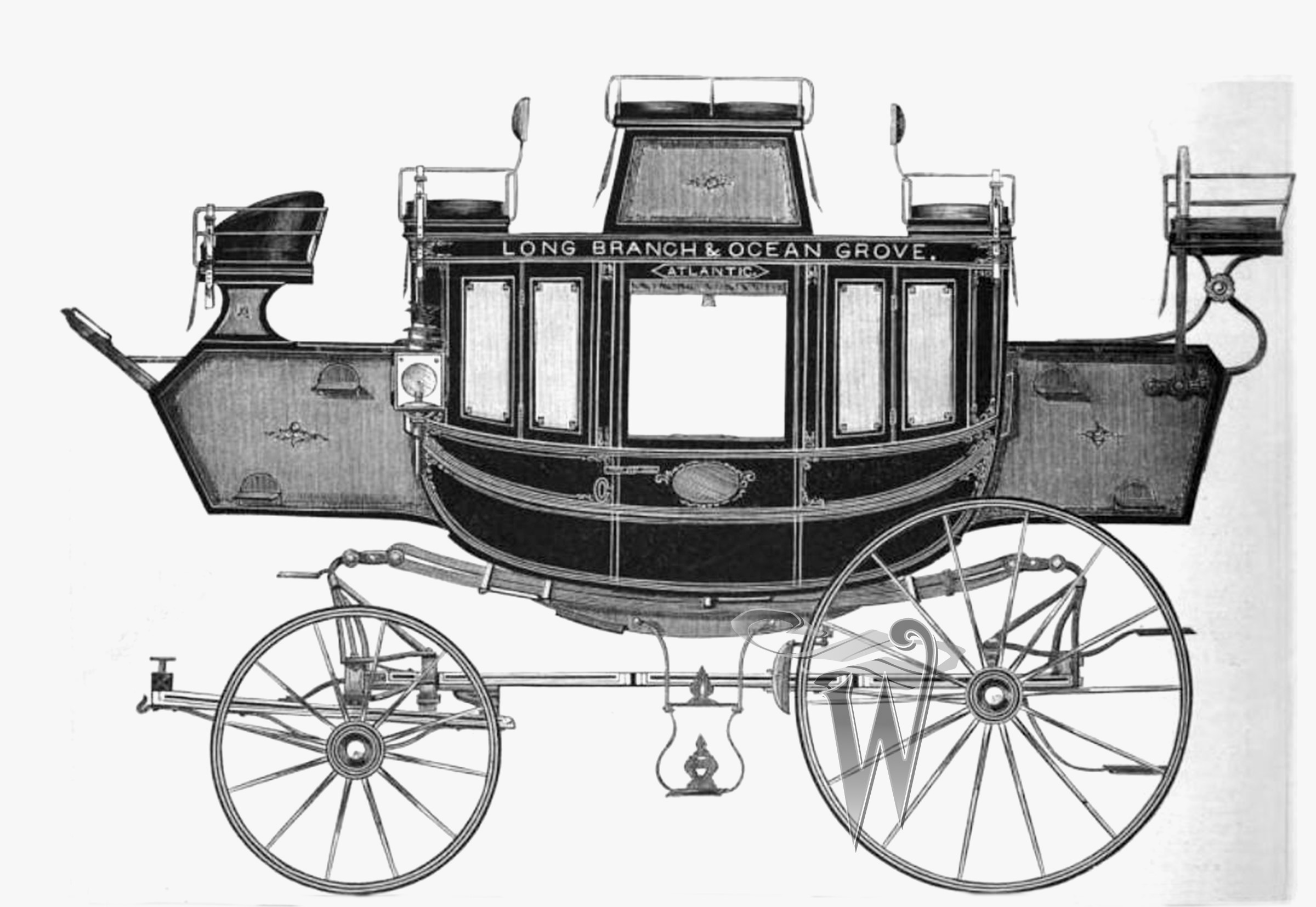
An extremely rare stagecoach design from 1877.
As shown in our transcription below, the 1877 article gives a fairly detailed profile of this new coach...
“The accompanying cut illustrates a new and original style of Coach, hung on thoroughbraces, which was designed by Mr. A.S. Dodd, of the New York Transfer Co., and built last spring at the shops of said company in West 28th Street. It was forwarded on June 29th last, with eight horses, to Long Branch, N.J., and made regular trips between that place and Ocean Grove during the summer months. On September 15th it returned to New York City, and since that time has been making daily trips from Madison-square to High-Bridge.
The body proper has the shape of the usual Concord Hotel Coach, to which are added the boots front and back, and the roof seats. It seats 23 persons outside, including the driver and guard, namely; 3 on the driving seat, and 4 on each of the other seats. The suspension on thoroughbraces causes quite a different motion than that produced by any kind of steel springs, but one that is very easy and agreeable.
The general finish of this vehicle is very rich and showy, the prevailing colors being red, white, and blue, with gold stripes and ornaments. The colors are distributed as follows: Body panels, red; body moldings, blue; boots, blue, their front and rear panels red, and front seat risers red. The running part is painted white, and striped with a broad line of red and two fine lines of blue. The interior, which is used by the occupants of the outside seats only in case of sudden storms, is very elegantly finished; it has six looking glasses, blue glass windows handsomely stained, is trimmed with green plush, and the roof is finely painted and varnished. A profusion of crests, scrolls and appropriate scenes, painted very artistically on the principal panels of the body, aid to attract attention to this very elegant and truly American style of coaching turnout.
The principal dimensions of the Atlantic are as follow: Width of body overall, 68 in., at front and back, 4 ft.7 in. Height of body clear, 62 in. Turn-under, 6 in. on each side. The body sides project 3 in. over the rocker. Front boot, 41 ½ in. wide. Hind boot, 45 in. wide. Wheels, 3 ft. 8 in. and 5 ft. 3 in. Hubs, 9 ½ in. diameter. Spokes, 12 and 14, 2 ¾ in. Rims, 3 in. Tires, 2 in.wide, ¾ in. thick. Axles, 2 1/8 in. Three perches, 3 ¼ x 5 ½ in. Track, 6 ft. 8 in., out to out. Thoroughbraces, 5 and 6, 3 in. wide. Mountings all silver-plated.”
The description is certainly a mouthful and yet another reminder that words of our need to study early views of these pieces to better understand how they were built, viewed, and used. Compared to western Concords and Overlands as well as most other stage configurations, this set of wheels seems to have been more festively-colored. It’s always interesting to locate previously unknown images. If the vehicle still exists, this type of information would be extremely pertinent as it provides us with first hand details confirming originality in both color and design.
Ultimately, period publications hold a wealth of information related to early vehicles. I’ve never seen this one profiled before so it’s a pleasure to uncover it and share the details with other enthusiasts. It would be an incredible find to locate this vehicle today. Perhaps one of our readers has seen it? If so, I'd love to hear from you.
